Machtesh Ramon is the most spectacular geological sight in the country. It is a window into the geological formation of the earth. The crater is 24 miles (40 km) long, 5 miles (8 km) wide, and 1600 feet (500 m) deep. The term machtesh is a geological term which means “mortar” as in mortar and pestle. Machtesh Qatan (Small) and Gadol (Large) look like mortar bowls in which grains are pounded with a pestle. This look is true of the big and little craters but not necessarily of Machtesh Ramon which is stretched out and narrow at one end.
Machtesh Ramon
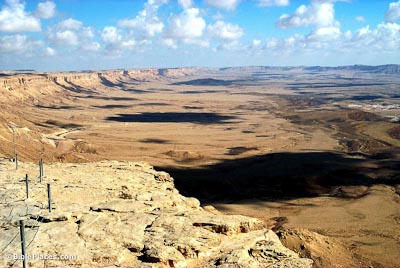
Machtesh Ramon
Ammonite Wall
Embedded in this exposed rock are thousands of ammonite fossils. These sea creatures are shaped like a snail and are up to 1 foot (35 cm) in diameter. This creature controlled its direction by expelling water in the opposite direction (like a jet engine). To ascend, it expelled water and to descend, it took in water.
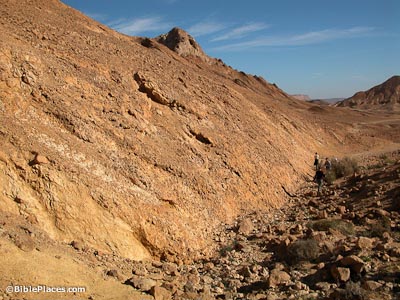
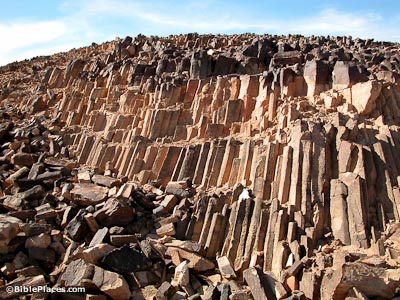
Resources of Machtesh Ramon
Peaks of ancient volcanoes, jagged chunks of quartzite, huge blocks of overturned rock, and beds of multicolored clays are just a few of the sites in the machtesh. Machtesh Ramon was expected to have an abundance of natural resources, but it has been disappointing that regard. Only small factories of raw materials, such as quartz and clay, are mined there today
Mining Activity
The most valuable resource of the Negev is the phosphate rock that is in the synclines of the northeastern Negev.
Gypsum is quarried in the mountains of Machtesh Ramon, and there is a factory for processing this in the middle of the crater. Gypsum is used for plaster of Paris and is a minor but important ingredient in cement manufacture. A mine here produces 10,000 tons (9,000 t) of this every year. The underground galleries stretch 16 miles (26 km).
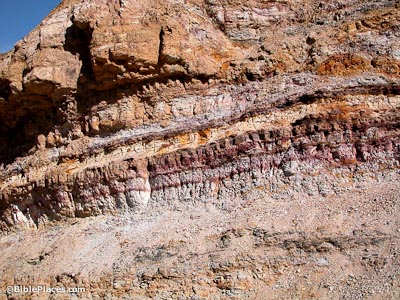
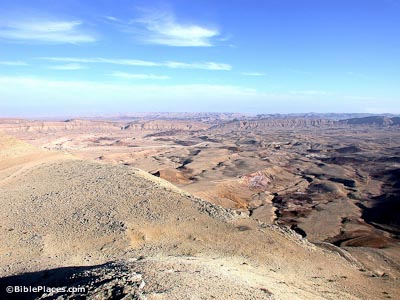
Machtesh Gadol
By definition a machtesh is an eroded valley, walled with steep cliffs on all sides, and drained by a single watercourse. The Machtesh Ramon is an exception to this as two rivers drain it. The Nahal Ramon is the major one, but the Nahal Ardon, a smaller one, drains into Nahal Nekaroth. The phenomenon of a machtesh is known only in Israel. This Hebrew term was introduced into worldly scientific literature. In addition to the three major machteshim, there are two small “twin machteshim” eroded into Mt. Arif, a little bit south of Machtesh Ramon.
Machtesh Qatan
This machtesh is the smallest of the major machteshim, measuring about 5 by 3 miles (8 x 5 km). It was charted in modern times by Jewish explorers in 1942. They named this one the “small” crater, and another nearby one the “large” (gadol) crater, unaware of the largest one to the south (Ramon). The photo at right shows where the river drains the crater through a crack in the edge.
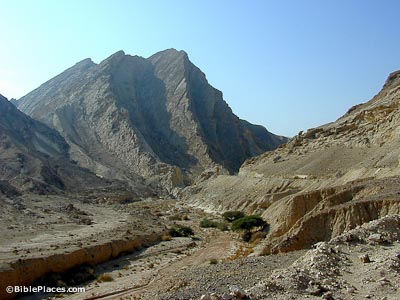

Download all of our Negev and the Wilderness photos!
$34.00 $49.99 FREE SHIPPING
Related Websites
See our page on Southern Wildlife.
Makhtesh Ramon (Israel Nature & Parks Authority) This page offers a lot of information about the site, including its ecology and geology.
Machtesh Ramon (Jewish Virtual Library) A good introductory article with a few pictures.
A Complete Guide to Makhtesh Ramon (the Ramon Crater) (Backpack Israel) Full of information on where to stop and what to see if you have the opportunity to visit.
The Ramon Crater (Makhtesh Ramon) (Tourist Israel) More brief than the above visiting article, this gives a basic introduction to the site.
The Ammonite Wall in Ramon Crater (Israel by Locals) A nice illustrated introduction to visiting this remarkable collection of fossils.
Postcard from Israel – Mitzpe Ramon (YouTube) Features some nice views of the crater.